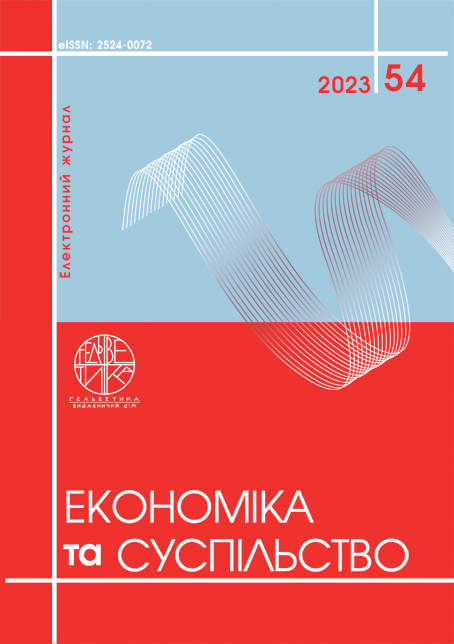FEATURES OF INTERNATIONAL MIGRATION PROCESSES IN THE GLOBALIZATION OF THE WORLD ECONOMY
Abstract
The article examines the features of the modern process of international migration. The directions of global migration, its importance for the international and national economies, especially the recipient countries are described. The author indicates that the processes of international migration in the world develop in a wave-like manner, as this is a reaction to the cyclicality in the development of the world economy, but at the same time, a clear tendency to the strengthening of migration processes over time can be observed. The author points out the emergence of a relatively new direction of international migration – population migration between developing countries. The article found out that this type of migration is primarily based on economic reasons. Another feature of international migration is outlined: the bidirectionality of migration flows, when the same state can be both a donor and a recipient of migrants. The author points to a clear trend of recent years, which is at the same time a sign of post-industrialization, is a change in the sectoral structure of immigrant employment: the percentage of those employed in the service sector is increasing, while the level of employment in traditional industrial sectors is decreasing. When analyzing modern migration processes, the author noted the transition to a completely new form of migration – "global migration", which is characterized by the movement of human capital in global space for an indefinite and unforeseeable period. It is also indicated to increase the scale of international migration and the involvement of new regions in migration processes. The article also singles out specific characteristics of the global migration system, such as: irreversible development, adaptability, structural complexity and integration, as well as fluctuating – that is, unpredictability due to the impossibility of predicting all possible challenges and risks. The article states that international migration, due to its globalization and scale, deepens national, political, ethnic, demographic and social contradictions in recipient countries. And therefore, migration constantly changes the socio-cultural structure of the host countries.
References
Brzezinski Zb. The Choice: Global Domination or Global Leadership. New York: Basic Books, 2004. 242 p.
McAuliffe, M. Доповідь про міграцію у світі, 2021 /M. McAuliffe, A.Triandafyllidou (eds.). // Міжнародна Організація з Міграції (МОМ), Женева, 2022. URL: https://publications.iom.int/system/files/pdf/WMR-2022-RU.pdf (дата звернення: 02.09.2023)
Oberg M. Early conflict prevention in ethnic crises, 1990–1998 / M. Oberg, F. Moller, P. Wallensteen // Conflict management and peace science. 2009. Vol. 26. № 1. P. 67–91.
Ravenstein E. The laws of migration. / Ernst Georg Ravenstein // Journal of the statistical society of London. Vol. 48.2 (1885): Pp. 167–235.
Романюк М. Міграції населення України за умов перехідної економіки: методологія і практика регулювання. Львів : Світ, 1999. 292 с.
Скрипник Н. Є., Горпинич О. О. Сучасні тенденції міжнародної міграції трудових ресурсів. Причорноморські економічні студії. 2016. Вип. 12(1). С. 35–38. URL: http://nbuv.gov.ua/UJRN/bses_2016_12(1)__10.
Шелюк В. Соціальна міграція: Етапи, функції, типи. Перспективи. 2001. № 3(15). С. 45–50.
Шульга М. Міграційні плани біженців. Розбудова держави. 1999. № 7–12. С. 47–55.
Brzezinski Zb.(2004) The Choice: Global Domination or Global Leadership. New York: Basic Books. 242 p.
McAuliffe, M., A. Triandafyllidou (eds.) (2022) WORLD MIGRATION REPORT 2022. International Organization for Migration (IOM), Geneva. Available at: https://publications.iom.int/system/files/pdf/WMR-2022-RU.pdf (accessed: September 02, 2023)
Oberg M., Moller F., Wallensteen P. (2009) Early conflict prevention in ethnic crises, 1990–1998. Conflict management and peace science. Vol. 26. № 1. Pp. 67–91.
Ravenstein E. (1885) The laws of migration. Journal of the statistical society of London. 48.2. Pp. 167–235.
Romaniuk M. (1999) Mihratsiyi naselennya Ukrayiny za umov perekhidnoyi ekonomiky: metodolohiya i praktyka rehulyuvannya [Migration of the population of Ukraine under the conditions of the transitional economy: methodology and practice of regulation]. Lviv: Svit. 292 p. [in Ukrainian]
Skripnik N.Ye., Gorpinich O. O. (2016) Suchasni tendentsiyi mizhnarodnoyi mihratsiyi trudovykh resursiv [Current trends in international labor migration]. Prychornomorsʹki ekonomichni studiy – Prychornomorsk economic studies, vol. 12(1), pp. 35–38. Available at: http://nbuv.gov.ua/UJRN/bses_2016_12(1)__10. (accessed: September 01, 2023) [in Ukrainian]
Shelyuk V. (2001) Sotsialʹna mihratsiya: Etapy, funktsiyi, typy [Social migration: Stages, functions, types] Perspektyvy – Perspectives, no. 3(15), pp. 45–50. [in Ukrainian]
Shulga M. (1999) Mihratsiyni plany bizhentsiv [Migration plans of refugees]. Rozbudova derzhavy – Development of the state, no. 7–12, pp. 47–55. [in Ukrainian]

This work is licensed under a Creative Commons Attribution 4.0 International License.


